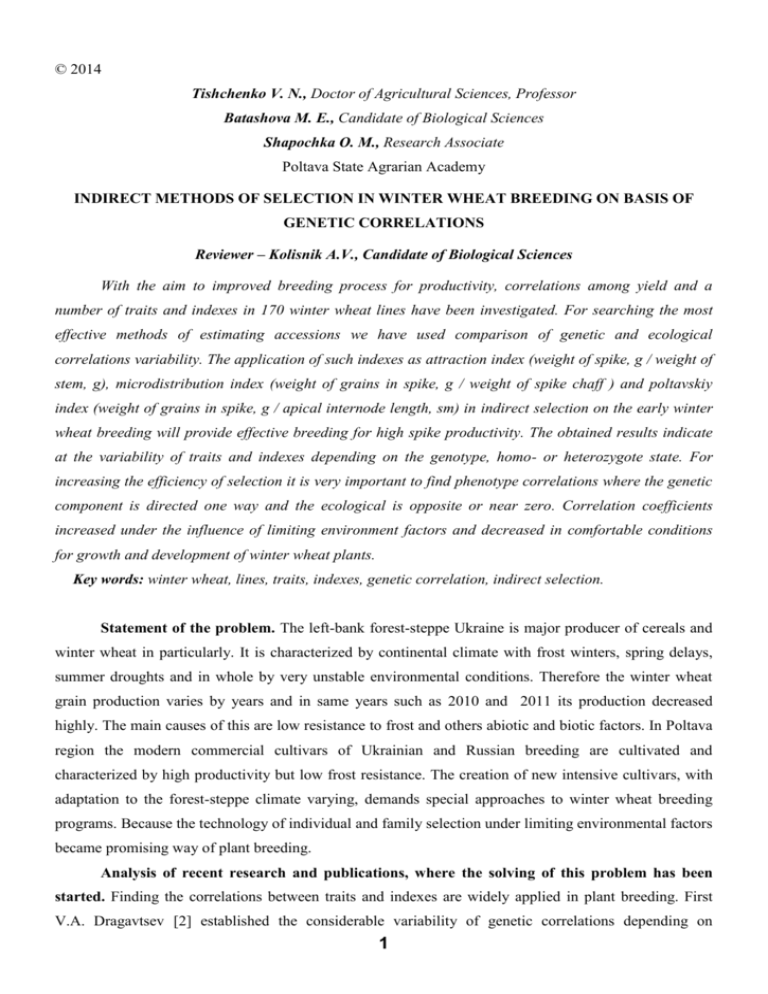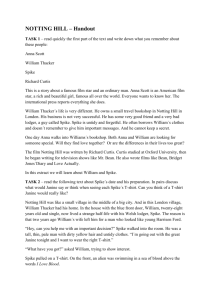UDC 633
advertisement

© 2014 Tishchenko V. N., Doctor of Agricultural Sciences, Professor Batashova M. E., Candidate of Biological Sciences Shapochka O. M., Research Associate Poltava State Agrarian Academy INDIRECT METHODS OF SELECTION IN WINTER WHEAT BREEDING ON BASIS OF GENETIC CORRELATIONS Reviewer – Kolisnik A.V., Candidate of Biological Sciences With the aim to improved breeding process for productivity, correlations among yield and a number of traits and indexes in 170 winter wheat lines have been investigated. For searching the most effective methods of estimating accessions we have used comparison of genetic and ecological correlations variability. The application of such indexes as attraction index (weight of spike, g / weight of stem, g), microdistribution index (weight of grains in spike, g / weight of spike chaff ) and poltavskiy index (weight of grains in spike, g / apical internode length, sm) in indirect selection on the early winter wheat breeding will provide effective breeding for high spike productivity. The obtained results indicate at the variability of traits and indexes depending on the genotype, homo- or heterozygote state. For increasing the efficiency of selection it is very important to find phenotype correlations where the genetic component is directed one way and the ecological is opposite or near zero. Correlation coefficients increased under the influence of limiting environment factors and decreased in comfortable conditions for growth and development of winter wheat plants. Key words: winter wheat, lines, traits, indexes, genetic correlation, indirect selection. Statement of the problem. The left-bank forest-steppe Ukraine is major producer of cereals and winter wheat in particularly. It is characterized by continental climate with frost winters, spring delays, summer droughts and in whole by very unstable environmental conditions. Therefore the winter wheat grain production varies by years and in same years such as 2010 and 2011 its production decreased highly. The main causes of this are low resistance to frost and others abiotic and biotic factors. In Poltava region the modern commercial cultivars of Ukrainian and Russian breeding are cultivated and characterized by high productivity but low frost resistance. The creation of new intensive cultivars, with adaptation to the forest-steppe climate varying, demands special approaches to winter wheat breeding programs. Because the technology of individual and family selection under limiting environmental factors became promising way of plant breeding. Analysis of recent research and publications, where the solving of this problem has been started. Finding the correlations between traits and indexes are widely applied in plant breeding. First V.A. Dragavtsev [2] established the considerable variability of genetic correlations depending on 1 environment changing. Opposite direction of genetic and ecological correlations under the influence of limiting factors have been found for a number of quantitative traits and indexes [3]. One of the main methods of our breeding is index method. Besides the registration of main quality and quantity traits the accessions are estimating by the values of relative traits, or indexes. The index is a complex notion where the numerator is often some component of productivity and the denominator is the component of vegetative part. Our investigations showed that harvest index (HI), attraction index (AI), microdistribution (MDI), Poltavskiy index (our elaboration) (PI) are the most suitable for using on early breeding of winter wheat. These indexes have a high genetic correlation coefficients with yield per unit of area as compared with grain weight per plant and high heritability coefficient (74-76 % beside 42% by grain weight per ear) [4]. During different period of time various ways of breeding have been elaborated for many crops using the index method. The application of indexes may have the particular aim – establishing regularity or relationship, which is not visible on absolute values of traits, for searching unique genotypes with new useful performance. Index method provides wide opportunities for variability analysis and heritability of quantitative traits for correlation and cluster analyses. It indicates ways of search and selection of productive genotypes by secondary, or marker traits and allows implement the search of such that may be used for individual and group selection on different stages of breeding. The aims of this research are: 1) to study the value and variability of genetic correlations of productivity traits and indexes in different winter wheat lines; 2) to make conclusions concerning to need to use a definite type of correlations in winter wheat breeding programs. Materials and methods of the research. 106 lines from 16 crossing combinations that were obtained after individual selection in F2 have been investigated in two replications. The field experiments have been carried out in the experimental field of Poltava State Agrarian Academy. During plant development and after harvesting we have investigated such traits and indexes: Traits: H – plant height, sm; WG – weight of grains in spike, g; WP – weight of plant, g; WS weight of spike, g; WST – weight of stem, g; WSC - weight of spike chaff, g; WTG – weight of 1,000 grains, g; NG – number of grains in spike; LS – length of spike, sm; AIL – apical internode length, sm; NS/m2 – number of spikes per 1 m2; YG – yield of grain. Indexes: HI – harvest index = weight of grains in spike, g (WG) / weight of plant, g (WP); AI – attraction index = weight of spike, g (WS) / weight of stem, g (WST); MDI – microdistribution index = weight of grains in spike, g (WG) / weight of spike chaff (WSC); PI – Poltavskiy index = weight of grains in spike, g (WG) / apical internode length, sm (AIL); SPI – spike productivity index = weight of grains in spike, g (WG) / weight of spike, g (WS). Measurements have been made in 20 plants in each line and in 100 – in cultivars. Coefficients of genetic correlation (rg) were estimated by interline links, coefficients of ecological correlation (re) – by intravariety and intraline links. For the analysis of parcial correlations the following traits were chosen: 2 yield of grain, g/m2 (YG); weight of grains in spike, g (WG); number of grains in spike (NG), weight of 1,000 grains, g (WTG), number of spikes per 1 m2 (NS/m2). Statistical analyses were performed by the software package STATISTICA. Results. A new program of selection and genetic research has been developed by us since 1999 based on ecological and genetic approach. It is aimed at creating varieties with improved parameters of yield, quality, adaptability and other useful characteristics. For searching the most effective methods of estimating winter wheat accessions we have used comparison of genetic correlations variability with ecological correlations variability of different traits and indexes. The variability of genetic and ecological correlations between some productivity traits and indexes was investigated (tabl.1). Attraction index (AI) – weight of spike, g (WS) / weight of stem, g (WST). It reflects the outflow of assimilative plastic matters from vegetative organs (stem, leaves) into generative (spike). Table 1 shows that AI have negative average and close genetic correlation (rg) with stem traits (Н, AIL, WST), with EL, WP and WTG – low and unreliable. Average and close positive rg were with NG. There was close positive rg between AI and HI. Ecological correlations differed from genetic, they were low and unreliable, excluding WST. Thus, attraction index defines formating number of flowers in spike, and accodingly the number of grains, without influencing WTG. Table 1. Coefficients of genetic rg and ecological re correlations between investigated quantitative traits and indexes in winter wheat lines Trait, index Weight of grain Plant height -.48/.21 Weight of grain Weight of plant .54/.89 Weight of spike .82/.85 Weight of spike .65 Number of grains .85/.88 Weight of 1,000 gr. .55/.41 Harvest index .72/.58 Attraction index .48/.00 Microdistribution i. .45/.32 Poltavskiy index .84 Apical internode l. -.09* Length of spike .26 * – correlation coefficient is unreliable rg/re Attraction index -.81/.08 .48/.00 -.19*/-.14* .47/.23 -.68/-.59 .68/.03* .06*/.06* .80/.10* .29/-.40 .69/.00 -.48/.00 -.04*/.10* Micro distribution index Poltavskiy index -.14*/-.28* .45/.32 -.49/.00 .00/.00 -.58/.15* .17*/.37 .73/.08 .75/.66 .29/-.40 .59/.50 -46/.00 -.52/.00 -.51 .84 .27 .59 -.16* .77 .35 .76 .69 .59 .00 .30 Microdistribution index (MDI) - weight of grains in spike, g (WG) / weight of spike chaff (WSC). It reflects the outflow assimilative plastic matters from vegetative part of the spike to grains. 3 Table 1 shows that MDI have negative and low correlations with stem traits (Н, AIL, WST). With WG trait rg and rе were positive. The tendency to negative genetic correlation when ecological is unreliable between MDI - LS and WS traits was received. The increase of spike length leads to the appearance the sterile flowers on the basis and apical part of the spike. As a result, MDI decreases and chaff weight increases after maturing. It was established that grain development in the spike basis and in its apical part are controlled by different genes [1], and they are all part of epigenic system, that determines the MDI value. So, the selection of genotypes with maximum MDI and optimal spike length will provide the creation of winter wheat lines and varieties with complete spike. The genetic correlation between AI and MDI was low positive (0.29) and confirm the conclusions of Dyakov and Dragavtsev that AI and MDI are controlled by two independent genetic systems. It allows combining the best characteristics of both indexes in one genotype by hybridization and selection. The application of indirect selection on the early winter wheat breeding by optimal combination of AI and MDI in one genotype will provide effective breeding for high spike productivity. The using of HI for analysis of great amount of plants is sufficiently laborious. Because we have use a new index Poltavskiy (PI) of our elaboration (Tishchenko, Chekalin 2005). PI is characterized by close positive correlation with spike productivity traits and negative correlations with stem traits (Н, AIL, WST), the high heritability coefficient (h2 = 0.51), the simplicity of PI measuring. It allows estimating a large amount of breeding material during a short period between harvesting and sowing winter wheat. Poltavskiy index (PI) = weight of grains in spike, g (WG) / apical internode length, sm (AIL). The given data concerning correlation of PI with main quantitative traits and indexes indicate to its successful application in winter wheat breeding. The obtained results indicate at the variability of traits and indexes depending on the genotype, homo- or heterozygote state. For increasing the efficiency of selection it is very important to find phenotype correlations where the genetic component is directed one way and the ecological is opposite or near zero. In our case the correlations of such type were between: WG – H; WG – AI; AI – H; AI – HI; AI – NG; AI – MDI; AI – AIL; MDI – WP; MDI – WST; MDI – WTG; MDI – AIL; MDI – LS (table 1). Their values are marked in the table. The influence of fluctuate environmental conditions by years and sowing terms at the gene expression determine variation of genetic correlations between the indexes and productivity characteristics. In this experiment the lines with max and min values of weight of grains in spike, g (WG), the number of grains in spike (NG), weight of 1,000 grains (WTG), yield, t/h (Y) were selected (table 2). 4 Table 2. Variation of genetic correlations (rg) between indexes and productivity traits in depend of their min and max values Traits Value rg HI AI PI SPI WG, g max 2,2 0, 49 0,38 0,75 0,48 min 0,87 0,82 0,69 0,85 0,60 NG max 42,5 0,47 0,36 0,73 0,48 min 29,4 0,69 0,49 0,75 0,18 WTG, g max 51,8 0,18 0,20 0,27* 0,29 min 37,6 0,42 0,18 -0,02* 0,48 Y, t/h max 5,79 045 0,37 .60 0,21 min 2,90 0,76 0,50 .90 0,71 * – correlation coefficient is unreliable The obtained data showed that the harvest index (HI) had more close genetic correlations with min values of all productivity traits. By the attraction index (AI) the picture was the same excluding WTG and correlations were not as strongly different as by HI. Correlations between AI and WTG were reliable but low. Poltavskiy index (PI) had very close correlation with WG (0.75 - 0.85) and NG (0.73 – 0.75) without depending of trait value. The rg of PI with WTG was unreliable, with Y was very close in case of min trait value: rg = 0.90, Y = 2.9 t/h. Spike productivity index (SPI) had more close correlations in cases of min trait value with WG, WTG and Y, but rg was not high. Winter wheat is characterized by autumnwinter-spring environment factors that influence on the number of spikes per 1 m2 (NS/m2): frost resistance, presence of genes of sensibility to photoperiod, necessity of definite duration of vernalization, “per se” genes and others. Genotype differences between lines generally are reflected in the number of plants which survived winter and on NS/m2 trait accordingly. In this connection the coefficient of variation (CV%) of NS/m2 is higher than other traits such as WG, NG и WTG in different year conditions in the most variants (tabl. 3). Table 3. Genetic coefficients variation (CV %) of WG, NG, WTG in winter wheat lines during different years of investigation № 1 2 3 4 5 6 7 8 9 10 11 12 13 14 Years, terms 2007-early sowing 2007-late sowing 2008-early sowing 2008-late sowing 2009-early sowing 2009-late sowing 2010-early sowing 2010-late sowing 2011-early sowing 2011-late sowing 2012-early sowing 2012-late sowing 2013-early sowing 2013-late sowing WG NG WTG NS/m2 13,94 16,65 15,89 15,35 13,54 11,44 19,96 20,04 12,95 13,01 19,48 19,46 16,52 14,95 14,69 15,75 13,50 12,90 12,59 11,26 14,67 13,11 10,40 9,99 17,71 17,02 14,95 12,43 7,70 6,81 10,77 11,80 7,95 7,33 15,88 17,02 7,48 7,98 13,93 8,81 8,30 7,62 16,65 17,40 16,40 17,66 16,65 16,35 18,92 18,59 15,63 15,72 20,60 18,68 15,95 15,50 5 Conclusions. The indirect selection method by the values of indexes may be effectively used for winter wheat breeding programs. Attraction index has shown close genetic correlation with the number of grains in spike, which indicates on its principal contribution to spike productivity on early stages of plant development. Microdistribution index has demonstrated close correlation with the weight of thousand grains, which indicates that MDI determines the outflow of plastic matters to grains beginning from flowering phase. The application of indirect selection on the early winter wheat breeding by optimal combination of AI and MDI in one genotype will provide effective breeding for high spike productivity. The using of new index Poltavskiy (PI) of our elaboration allows estimating a large amount of breeding material during a short period between harvesting and sowing winter wheat. PI is characterized by close positive correlation with spike productivity traits, the high heritability coefficient and the simplicity of measuring. Correlation coefficients increased under the influence of limiting environment factors and decreased in comfortable conditions for growth and development of winter wheat plants. REFERENCES 1. Dyakov A.V., Dragavtsev V.A. Конкурентноспособность растений в связи сселекцией. Надежность оценки генотипов по фенотипам / А.В. Дьяков, В.А. Драгавцев // Генетика. - 11, № 5. - 1975. - С. 11-22. 2. Dragavtsev V.A. and others. Модель эколого-генетического контроля количественных признаков растений / В.А. Драгавцев, П.П. Литун, Н.М. Шкель, Н.Н. Нечипоренко // Доклады АН СССР. - 1984. - Т.274. - №3. - С. 720-723. 3. Chekalin N.M. Use of inderect selection in grain legume breding / In: 2nd European Conf. on Grain Legumes, Copenhagen, 1995. - p. 200. 4. Tishchenko V.N., Chekalin N.M. Генетические основы адаптивной селекции озимой пшеницы в зоне Лесостепи. / В.Н. Тищенко, Н.М. Чекалин. Полтава, 2005. - 270 с. 6









